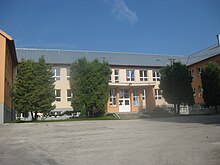Primary school
| Childcare |
|---|
| At home |
| Outside the home |
| Educational settings |
| Institutions and standards |
| Related |
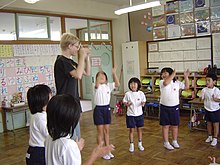
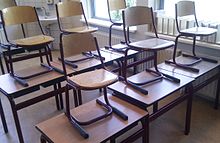
A primary school (in Ireland, the UK,[1] Australia,[2] New Zealand, & South Africa), junior school (in Australia[3][4]), elementary school or grade school (in the US & Canada) is a school for primary education of children who are four to eleven years of age (and sometimes up to thirteen years of age). It typically comes after preschool and before secondary school.
The International Standard Classification of Education considers primary education as a single phase where programmes are typically designed to provide fundamental skills in reading, writing, and mathematics and to establish a solid foundation for learning. This is ISCED Level 1: Primary education or first stage of basic education.[5]
History of elementary education[]
During Greek and Roman times, boys were educated by their mothers until the age of seven, then according to the culture of their location and times, would start formal education. In Sparta until twelve, it would be at a military academy building up physical fitness and combat skills, but also reading, writing and arithmetic[6]:25 while in Athens the emphasis would be on understanding the laws of the polis, reading, writing, arithmetic and music with gymnastics and athletics,[6]:29, 30 and learning the moral stories of Homer. Girls received all their education at home. In Rome the primary school was called the ludus; the curriculum developed over the centuries featuring the learning of both Latin and Greek. In AD 94, Quintilian published the systematic educational work, Institutio oratoria.[6]:68 He distinguished between teaching and learning, and that a child aged between 7 and 14 learned by sense experience, learns to form ideas, develops language and memory. He recommended that teachers should motivate their pupils by making the teaching interesting, rather than by corporal punishment.[6]:70 The trivium (grammar, rhetoric and logic) and quadrivium (arithmetic, geometry, astronomy and music) were legacies of the Roman curriculum.[6]:88
The medieval church and education in Europe[]

As the Roman influence waned, the great cathedral schools were established to provide a source of choristers and clergy. Kings School, Canterbury dates from 597. The Council of Rome in 853 specified that each parish should provide elementary education: religious ritual but also reading and writing Latin.[6]:81 The purpose of education was to explain salvation, not social change. The church had a monopoly on education; the feudal lords concurred and allowed their sons to be educated at the few church schools. The economy in most of Europe was agrarian and the children of serfs started work as soon as they were able. It was accepted as a truth by Christians that man was created by God in the image of Adam with his share of original sin and that a boy was born sinful. Therefore, only the teachings of the church and the sacraments could redeem him.[6]:77, 85 The parishes provided elementary education- but had no requirement to provide it to every child. The need was to produce priests, and in a stable kingdom such as that of Charlemagne, administrators with elementary writing skills in Latin and the arithmetic needed to collect taxes and administer them. Alcuin (735–804) developed teaching material that was based on the catechetical method- repeating and memorizing questions and answers, although often understanding the information was not important. These skills were also needed in the great abbeys such as Cluny. There was a divergence between the needs of town and monasteries and we see the development of the parish, chantry, monastic, and cathedral schools. With the entry of women into church life, convents were established, and with them convent schools. Girls entered at the age of eight and were taught Latin grammar, religious doctrine, and music, and the women's arts of spinning, weaving, tapestry, painting, and embroidery.[6]:84 Bede entered the monastic school at Jarrow at the age of seven and became a writer and historian. Chantry schools were the result of charitable donations and educated the poor. Beginning in 804, parishes were obliged to have a school from 804, and cathedrals had to establish schools after the Lateran Council of 1179. Elementary education was mainly to teach sufficient Latin for the trivium and the quadrivium that formed the basis of the secondary curriculum.[7]
Renaissance[]

While Humanism had a great change on the secondary curriculum, the primary curriculum was unaffected.[7] It was believed that by studying the works of the greats, ancients who had governed empires, one became fit to succeed in any field. Renaissance boys from the age of five learned Latin grammar using the same books as the Roman child. There were the grammars of Donatus and Priscian followed by Caesar's Commentaries and then St Jerome's Latin Vulgate.[8]
Wealthy boys were educated by tutors. Others were educated in schools attached to the parishes, cathedrals, or abbeys. From the 13th century, wealthy merchants endowed money for priests to "establish as a school to teach grammar". These early grammar schools were to teach basic, or elementary grammar, to boys. No age limit was specified. Early examples in England included Lancaster Royal Grammar School, Royal Latin School, Buckingham, and Stockport Grammar School. The Reformation and the Dissolution of the Monasteries (1548) disrupted the funding of many schools. The schools petitioned the King, Edward VI, for an endowment. Examples of schools receiving endowments are King Edward VI Grammar School, Louth, King Edward VI Grammar School, Norwich and King Edward VI School, Stratford-upon-Avon, where William Shakespeare was thought to be a pupil from the age of 7 to 14.
Paupers and the poor[]
Though the Grammar schools which were set up to deliver elementary education, they did require their entrants to already have certain skills. In particular, they expected them to be able to read and write in the vernacular. There was a need for something more basic.[9]
This was addressed by Dame schools, then charity schools, often set up by the churches (), Bell's British Schools and Joseph Lancaster's National Schools.[9]
Educational philosophies[]

Certain movements in education had relevance in all of Europe and its diverging colonies. The Americans were interested in the thoughts of Pestalozzi, Joseph Lancaster, Owen[6]:208 and the Prussian schools.[6]:4
Levels of education[]
| Level | ISCED 2011 | Description | Corresponding ISCED 1997 level |
|---|---|---|---|
| 0 | Early childhood Education (01 Early childhood educational development) | Education designed to support early development in preparation for participation in school and society. Programmes designed for children below the age of 3. | None |
| 0 | Early childhood Education (02 Pre-primary education) | Education designed to support early development in preparation for participation in school and society. Programmes designed for children from age 3 to the start of primary education. | Level 0: Pre-primary education. |
| 1 | Primary education | Programmes typically designed to provide students with fundamental skills in reading, writing, and mathematics and to establish a solid foundation for learning. | Level 1: Primary education or first stage of basic education. |
| 2 | Lower secondary education | First stage of secondary education building on primary education, typically with a more subject-oriented curriculum. | Level 2: Lower secondary education or second stage of basic education |
| 3 | Upper secondary education | Second/final stage of secondary education preparing for tertiary education or providing skills relevant to employment. Usually with an increased range of subject options and streams. | Level 3: Upper secondary education |
| 4 | Post-secondary non-tertiary education | Programmes providing learning experiences that build on secondary education and prepare for labour market entry or tertiary education. The content is broader than secondary but not as complex as tertiary education. | Level 4: Post-secondary non-tertiary education |
| 5 | Short-cycle tertiary education | Short first tertiary programmes that are typically practically based, occupationally specific, and prepare for labour market entry. These programmes may also provide a pathway to other tertiary programmes. | Level 5B: First stage of tertiary education: typically shorter, more practical/technical/occupationally specific programmes leading to professional qualifications. |
Terminology: descriptions of cohorts[]
Within the English speaking world, there are three widely used systems to describe the age of the child. The first is the "equivalent ages", then countries that base their education systems on the "English model" use one of two methods to identify the year group, while countries that base their systems on the "American K–12 model" refer to their year groups as "grades". Canada also follows the American model, although its names for year groups are put the number after the grade: For instance, "Grade 1" in Canada, rather than "First Grade" in the United States. This terminology extends into the research literature.[11]
In Canada, education is a Provincial, not a Federal responsibility. For example, the province of Ontario also had a "Grade 13," designed to help students enter the workforce or post-secondary education, but this was phased out in the year 2003.
| Equivalent ages | 4–5 | 5–6 | 6–7 | 7–8 | 8–9 | 9–10 | 10–11 |
|---|---|---|---|---|---|---|---|
| U.S. (grades) | Pre-K | K | 1 | 2 | 3 | 4 | 5 |
| Ireland | Junior Infants | Senior Infants | 1st Class | 2nd Class | 3rd Class | 4th Class | 5th Class |
| England (forms) | Reception | Infants | Top infants | Junior 1 | Junior 2 | Junior 3 | Junior 4 |
| England (year) | R | 1 | 2 | 3 | 4 | 5 | 6 |
| England (keystage) | EYFS/FS | KS1 | KS1 | KS2 | KS2 | KS2 | KS2 |
| ISCED level | 0 | 1 | 1 | 1 | 1 | 1 | 1 [11] |
| Equivalent ages | 11–12 | 12–13 | 13–14 | 14–15 | 15–16 | 16–17 | 17–18 |
|---|---|---|---|---|---|---|---|
| U.S. (grades) | 6 | 7 | 8 | 9 | 10 | 11 | 12 |
| Ireland | 6th Class | 1st Year | 2nd Year | 3rd Year | 4th Year | 5th Year | 6th Year |
| England (forms) | First | Second | Third | Fourth | Fifth | Lower Sixth | Upper Sixth |
| England (year) | 7 | 8 | 9 | 10 | 11 | 12 | 13 |
| England (keystage) | KS3 | KS3 | KS3 | KS4 | KS4 | KS5 | KS5 |
| ISCED level | 2 | 2 | 2 | 3 | 3 | 3 | 3 [11] |
Primary schools[]
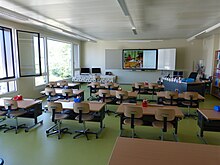
In most parts of the world, primary education is the first stage of compulsory education, and is normally available without charge, but may also be offered by fee-paying independent schools. The term grade school is sometimes used in the US, although this term may refer to both primary education and secondary education.[citation needed]
The term primary school is derived from the French école primaire, which was first used in an English text in 1802.[12] In the United Kingdom, "elementary education" was taught in "elementary schools" until 1944, when free elementary education was proposed for students over 11: there were to be primary elementary schools and secondary elementary schools;[a] these became known as primary schools and secondary schools.
- Primary school is the preferred term in the United Kingdom, Ireland and many Commonwealth nations, and in most publications of the United Nations Educational, Scientific, and Cultural Organization (UNESCO).[14]
- Elementary school is still preferred in some countries, especially in the United States and Canada.[citation needed]
In some parts of the United States, "primary school" refers to a school covering kindergarten through to second grade or third grade (K through 2 or 3); the "elementary school" includes grade three through five or grades four to six.[citation needed] In Canada, "elementary school" almost everywhere refers to Grades 1 through 6; with Kindergarten being referred to as "preschool."[citation needed]
Elementary schools[]
Though often used as a synonym, "elementary school" has specific meanings in different locations.
- Elementary schools also known as Board Schools were first established in England and Wales in 1870 by the Forster Act (Elementary Education Act 1870).[6] Most of these schools became primary schools in the late 1940s, following the historic compromise in the 1944 Education Act.
- Elementary school (United States): were first promoted in 1647 in the Massachusetts Bay Colony.[15] Today, there are currently approximately 92,858 elementary schools (68,173 public, 24,685 private).[16] In the United States, elementary schools usually have six grades with pupils aged between 6 and 13 years old, but the upper age limit can also be 10 or 14 years.[17] The Elementary and Secondary Education Act of 1965 was designed to fund primary and secondary education.[18] It also emphasized equal access to education and established high standards and accountability.[19]
- Elementary schools in Japan were first established by 1875.[20] In Japan, the age of pupils in elementary school ranges from 6 to 12, after which the pupils enter junior high school.

Theoretical framework of primary school design[]
School building design does not happen in isolation. The building (or school campus) needs to accommodate:
- Curriculum content
- Teaching methods
- Costs
- Education within the political framework
- Use of school building (also in the community setting)
- Constraints imposed by the site
- Design philosophy
Each country will have a different education system and priorities.[21] Schools need to accommodate students, staff, storage, mechanical and electrical systems, storage, support staff, ancillary staff and administration. The number of rooms required can be determined from the predicted roll of the school and the area needed.
According to standards used in the United Kingdom, a general classroom for 30 reception class or infant (Keystage 1) students needs to be 62 m2, or 55 m2 for juniors (Keystage 2).[22] Examples are given on how this can be configured for a 210 place primary with attached 26 place nursery[23] and two-storey 420 place (two form entry) primary school with attached 26 place nursery.[24]
Building design specifications[]
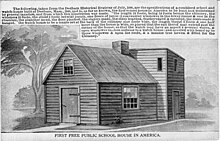



The building providing the education has to fulfill the needs of: The students, the teachers, the non-teaching support staff, the administrators and the community. It has to meet general government building guidelines, health requirements, minimal functional requirements for classrooms, toilets and showers, electricity and services, preparation and storage of textbooks and basic teaching aids.[25] An optimum school will meet the minimum conditions and will have:
- adequately sized classrooms—where 60 m2 in considered optimum but 80 m2 for the reception class
- specialised teaching spaces
- a staff preparation room
- staff welfare facilities
- an administration block
- multipurpose classrooms
- student toilet facilities
- a general purpose school hall
- adequate equipment
- storage
- a library or library stocks that are regularly renewed
- computer rooms or media centres
- counselling, sick and medical examination rooms[25]
Government accountants having read the advice then publish minimum guidelines on schools. These enable environmental modelling and establishing building costs. Future design plans are audited to ensure that these standards are met but not exceeded. Government ministries continue to press for the 'minimum' space and cost standards to be reduced.
The UK government published this downwardly revised space formula for primary schools in 2014. It said the floor area should be 350 m2 + 4.1 m2/pupil place. The external finishes were to be downgraded to meet a build cost of £1113/m2.[26]
Governance and funding[]
There are three main ways of funding a school: it can funded by the state through general taxation, it can be funded by a pressure group such as the mosque or the church, it can be funded by a charity or it can be funded by contributions from the parents or a combination of these methods. Day to day oversight of the school can through a board of governors, the pressure group, or the owner.[citation needed]
The United Kingdom allowed most elementary education to be delivered in church schools whereas in France this was illegal as there is strict separation of church and state.
Accountability[]
This can be through informal assessment by the staff and governors such as in Finland, or by a state run testing regime such as Ofsted in the United Kingdom.[27]
See also[]
- Dame school
- Early childhood education
- Educational stage
- Virtual reality in primary education
- Vocal school (Blab school)
Notes[]
- ^ Secondary elementary school: A term already used by London County Council from 1921 to describe some 11–14 schools,[13] and term still in use in Florida, Ohio and Brazil.
References[]
- ^ "Primary education (4 to 11 years)". Cambridgeshire County Council. Retrieved 21 February 2021.
- ^ Technology, Elcom. "Education system overview". www.studyinaustralia.gov.au. Retrieved 21 February 2021.
- ^ Barker. "Learning for today. Thinking for tomorrow". Barker. Retrieved 21 February 2021.
- ^ "Early Years: Prep to Year 3". Ormiston College. Retrieved 21 February 2021.
- ^ Annex III in the ISCED 2011 English.pdf Archived 25 December 2018 at the Wayback Machine Navigate to International Standard Classification of Education (ISCED)
- ^ Jump up to: a b c d e f g h i j k Gerald L. Gutek (14 December 1994). A History of the Western Educational Experience: Second Edition. Waveland Press. p. 203. ISBN 978-1-4786-3010-4. Archived from the original on 2 September 2019. Retrieved 16 April 2019.
- ^ Jump up to: a b Black, Robert (2001). "Humanism and Education in Medieval and Renaissance Italy: Tradition and Innovation in Latin Schools from the Twelfth to the Fifteenth Century": 489. ISSN 1530-9169. Cite journal requires
|journal=(help) - ^ Bertlett, Kenneth (15 December 2016). "The Italian Renaissance - The Education and Learning During the Renaissance". The Great Courses Daily. University of Toronto. Archived from the original on 19 April 2019. Retrieved 19 April 2019.
- ^ Jump up to: a b The Education of the Working Classes to 1870 | British History Online. London. 1969. p. 240. Archived from the original on 22 April 2019. Retrieved 22 April 2019.
- ^ "International Standard Classification of Education 2011" (PDF). Archived from the original (PDF) on 15 December 2017. Retrieved 25 December 2017.
- ^ Jump up to: a b c Ward, Ken. "British and American Systems (Grades)". trans4mind.com. Archived from the original on 31 March 2017. Retrieved 30 March 2017.
- ^ "Online Etymology Dictionary". Archived from the original on 2 July 2017. Retrieved 9 November 2007.
- ^ "Hadow Report (1926)". educationengland.org.uk. Archived from the original on 25 June 2019. Retrieved 17 April 2019.
- ^ "Britannica Academic". academic.eb.com. Archived from the original on 14 March 2020. Retrieved 1 November 2019.
- ^ "Historical Timeline of Public Education in the US". Race Forward. 13 April 2006. Archived from the original on 3 July 2018. Retrieved 8 February 2018.
- ^ "Digest of Education Statistics, 2001" (PDF). National Center for Education Statistics. Archived (PDF) from the original on 9 August 2017. Retrieved 12 August 2017.
- ^ Snyder, Thomas D.; Hoffman, Charlene M. (2001). Digest of Education Statistics 2001 (PDF). Institute of Education Sciences, Washington: National Center for Education Statistics. p. 7, fig. 1. Archived (PDF) from the original on 9 August 2017. Retrieved 19 August 2017.
- ^ "Secretary Riley Reignites the Math Wars". hoover.org. Archived from the original on 29 March 2018. Retrieved 28 March 2018.
- ^ ESEA. "No Child Left Behind Act". www.k12.wa.us. Archived from the original on 26 March 2018. Retrieved 28 March 2018.
- ^ "The Establishment of Elementary Schools and Attendance". JAPAN'S MODERN EDUCATIONAL SYSTEM. Ministry of Education, Culture, Sports, Science and Technology, Japan. Archived from the original on 20 December 2017. Retrieved 12 August 2017.
- ^ Liew Kok-Pun, Michael (1981). "Design of secondary schools:Singapore a case study" (PDF). Educational Building reports. Voume 17: UNESCO. p. 37. Archived (PDF) from the original on 4 April 2017. Retrieved 3 April 2017.CS1 maint: location (link)
- ^ "Mainstream schools: area guidelines". GOV.UK. Archived from the original on 18 April 2019. Retrieved 18 April 2019.
- ^ "Baseline design: 210 place primary school with a 26 place nursery". GOV.UK. Archived from the original on 18 April 2019. Retrieved 18 April 2019.
- ^ "Baseline design: 420 place primary school with 26 place nursery". GOV.UK. Archived from the original on 18 April 2019. Retrieved 18 April 2019.
- ^ Jump up to: a b "Guidelines relating to planning for public school infrastructure". Department of Basic Education, Republic of South Africa. 2012. Archived from the original on 7 September 2015. Retrieved 3 April 2017.
- ^ "Baseline designs for schools: guidance - GOV.UK". www.gov.uk. Education Funding Agency. 11 March 2014. Archived from the original on 4 April 2017. Retrieved 3 April 2017.
- ^ "Standards and Testing Agency". GOV.UK. Archived from the original on 18 March 2020. Retrieved 28 January 2020.
External links[]
- National Center for Education Statistics (NCES) (United States)
- Elementary Schools with Education and Crime Statistics (United States)
- Australian CensusAtSchool (Australia)
- Canadian Education Statistics Council (CESC) (United States)
- Office for National Statistics (ONS) (United Kingdom)
- BB103_Area_Guidelines_for_Mainstream_Schools (2014) UK
- National Center for Education Statistics (NCES) (United States)
- OECD Standardised designs (2011)
- Elementary and primary schools
- Educational stages
- Primary education
- School terminology
- School types
